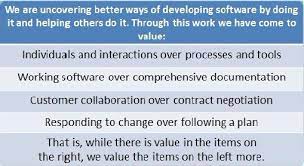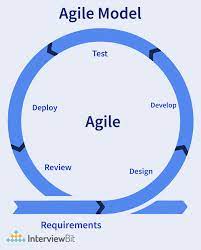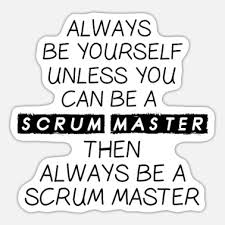The Manifesto for Agile Software Development is a set of guiding principles that have revolutionized the software development industry. Created in 2001 by a group of software developers who were frustrated with the slow and cumbersome processes of traditional software development, the manifesto has since become a cornerstone of modern software development practices.
The manifesto is built around four core values: individuals and interactions over processes and tools, working software over comprehensive documentation, customer collaboration over contract negotiation, and responding to change over following a plan. These values prioritize human interaction, delivering working software as quickly as possible, involving customers in the development process, and being able to pivot quickly when necessary.
One of the key benefits of agile software development is its focus on delivering value to customers as quickly as possible. This means that teams work in short iterations, often called sprints, where they deliver small pieces of functionality that can be tested and reviewed by customers. This approach allows teams to get feedback early and often, which helps them ensure that they are building what customers actually want.
Another important aspect of agile development is its emphasis on collaboration between team members. The manifesto values individuals and interactions over processes and tools because it recognizes that people are the most important part of any project. By encouraging teams to work closely together and communicate frequently, agile methods help ensure that everyone is aligned on goals and priorities.
Agile methods also prioritize flexibility and adaptability. The manifesto values responding to change over following a plan because it recognizes that projects rarely go exactly according to plan. By being able to pivot quickly when circumstances change or new information becomes available, agile teams can stay focused on delivering value even in uncertain environments.
In conclusion, the Manifesto for Agile Software Development has had an enormous impact on the way software is developed today. By prioritizing human interaction, delivering working software quickly, involving customers in the process, and being adaptable in the face of change, agile methods have helped countless teams deliver better software faster. Whether you are a software developer or simply interested in how modern software is built, understanding the principles of agile development is essential.
6 Tips for Crafting an Effective Manifesto for Agile Software Development
- Keep it short and simple – A manifesto should be easy to understand and not too long.
- Focus on the core values – Highlight the most important aspects of agile software development such as collaboration, customer feedback, and continuous improvement.
- Include measurable goals – Outline specific objectives that you can track progress against in order to measure success.
- Involve everyone in the process – Make sure all stakeholders are involved in creating the manifesto so everyone is on board with its contents.
- Be flexible – Agile software development is an ever-changing landscape, so make sure your manifesto is open to change as needed over time to reflect new trends or technologies.
- Communicate it clearly – Once you have created your manifesto, ensure that everyone understands it by clearly communicating its contents and purpose within your organization.
Keep it short and simple – A manifesto should be easy to understand and not too long.
One of the key tips for creating a successful manifesto for agile software development is to keep it short and simple. A manifesto should be easy to understand and not too long, so that its core principles can be easily communicated and remembered.
When creating a manifesto, it’s important to focus on the key values and principles that are most important to your team or organization. These values should be clear, concise, and easy to understand. Avoid using overly technical language or jargon that might confuse readers who are not familiar with your industry or field.
A shorter manifesto is also more likely to be read and shared by others. In today’s fast-paced world, people are bombarded with information from all sides. A long, complicated manifesto is likely to get lost in the noise, but a short and simple one has a better chance of catching people’s attention.
Another benefit of keeping your manifesto short is that it forces you to prioritize the most important values and principles. By focusing only on what really matters, you can create a more impactful document that resonates with your audience.
In conclusion, when creating a manifesto for agile software development, remember to keep it short and simple. Focus on the key values and principles that are most important to your team or organization, use clear and concise language, and prioritize brevity over length. By doing so, you can create a powerful document that communicates your vision clearly and effectively.
Focus on the core values – Highlight the most important aspects of agile software development such as collaboration, customer feedback, and continuous improvement.
When adopting agile software development practices, it is important to remember the core values that underpin this methodology. The Manifesto for Agile Software Development outlines four core values that prioritize human interaction, delivering value to customers, and being adaptable in the face of change.
One important tip for those new to agile development is to focus on these core values. Collaboration is key, as agile teams work closely together and communicate frequently to ensure everyone is aligned on goals and priorities. Customer feedback is also crucial, as teams deliver small pieces of functionality that can be tested and reviewed by customers early and often. This helps ensure that teams are building what customers actually want.
In addition, continuous improvement is a key aspect of agile development. Teams should always be looking for ways to improve their processes and practices, whether it’s through retrospectives or other forms of feedback. By focusing on continuous improvement, teams can stay ahead of the curve and keep delivering value even as circumstances change.
By highlighting these most important aspects of agile software development – collaboration, customer feedback, and continuous improvement – teams can stay focused on what really matters. These core values are what make agile development so effective at delivering better software faster. So whether you are new to agile or a seasoned practitioner, never forget the importance of focusing on the core values that underpin this methodology.
Include measurable goals – Outline specific objectives that you can track progress against in order to measure success.
One of the key principles of the Manifesto for Agile Software Development is to include measurable goals in your projects. This means outlining specific objectives that you can track progress against in order to measure success.
Measurable goals are important for several reasons. First, they help ensure that everyone on the team is aligned on what success looks like. By defining specific objectives, you can avoid misunderstandings and ensure that everyone is working towards the same goal.
Second, measurable goals help keep teams focused and motivated. When you have clear objectives to work towards, it’s easier to stay on track and avoid distractions. And when you make progress towards those objectives, it can be incredibly motivating for the team.
Finally, measurable goals are essential for measuring success and identifying areas for improvement. By tracking progress against specific objectives, you can see what’s working well and what needs improvement. This helps teams continuously improve their processes and deliver better results over time.
So how do you include measurable goals in your agile projects? Start by defining specific objectives that are aligned with your overall project goals. These could be things like delivering a certain number of features by a certain date or achieving a certain level of user engagement.
Once you have defined your objectives, make sure they are measurable. This means defining specific metrics that you can track progress against. For example, if one of your objectives is to increase user engagement, you might define a metric like “number of daily active users” or “average time spent on site”.
Finally, make sure you track progress against these metrics regularly and use them to guide decision-making throughout the project lifecycle. By including measurable goals in your agile projects, you can ensure that everyone is aligned on what success looks like, stay focused and motivated throughout the project, and continuously improve over time.
Involve everyone in the process – Make sure all stakeholders are involved in creating the manifesto so everyone is on board with its contents.
One of the most important tips for implementing the Manifesto for Agile Software Development is to involve everyone in the process. This means making sure that all stakeholders, including developers, customers, and business leaders, are involved in creating the manifesto so that everyone is on board with its contents.
By involving everyone in the process of creating the manifesto, you can help ensure that it reflects the needs and priorities of all stakeholders. This will help build consensus around the principles of agile development and make it easier to implement them across your organization.
In addition to building consensus, involving everyone in the process of creating the manifesto can also help foster a sense of ownership and buy-in among team members. When people feel like they have had a say in shaping the direction of a project or initiative, they are more likely to be invested in its success.
Finally, involving everyone in the process can also help surface any potential issues or challenges early on. By soliciting feedback from all stakeholders, you can identify potential roadblocks or areas where more work may be needed before moving forward.
In conclusion, involving everyone in the process of creating an agile development manifesto is essential for building consensus, fostering ownership and buy-in among team members, and identifying potential issues early on. By making sure all stakeholders are involved from the outset, you can set your team up for success as you work to implement agile practices across your organization.
Be flexible – Agile software development is an ever-changing landscape, so make sure your manifesto is open to change as needed over time to reflect new trends or technologies.
One of the most important tips to keep in mind when working with the Manifesto for Agile Software Development is to be flexible. Agile development is all about being adaptable and responsive to change, and this applies not just to the software development process itself, but also to the manifesto that guides it.
As new trends and technologies emerge, it’s important to revisit your manifesto periodically and make sure that it still reflects your team’s values and priorities. This might mean adding new principles or revising existing ones to better align with your current goals.
Being open to change in this way can help ensure that your team stays on track and continues delivering value even as the software development landscape evolves. It also helps foster a culture of continuous improvement, where teams are always looking for ways to refine their processes and deliver better results.
Of course, being flexible doesn’t mean abandoning your core values or principles altogether. The four core values of the Manifesto for Agile Software Development remain as relevant today as they were when they were first written. However, by being open to change and willing to adapt over time, you can ensure that your team stays at the forefront of agile software development practices and continues delivering value for years to come.
Communicate it clearly – Once you have created your manifesto, ensure that everyone understands it by clearly communicating its contents and purpose within your organization.
The Manifesto for Agile Software Development is a powerful tool for any organization looking to improve its software development practices. However, simply creating a manifesto is not enough – it is equally important to ensure that everyone in your organization understands its contents and purpose. This is where clear communication comes in.
When you have created your manifesto, take the time to communicate it clearly to everyone in your organization who will be involved in software development. This includes developers, project managers, product owners, and other stakeholders. Make sure that everyone understands what the manifesto means and how it will impact their work.
One effective way to communicate your manifesto is to hold a team meeting or workshop where you can discuss its contents in detail. Encourage open discussion and feedback so that everyone has a chance to ask questions and provide input. This will help ensure that everyone is on the same page and understands the goals of the manifesto.
Another important aspect of clear communication is ensuring that the manifesto remains visible over time. You can do this by displaying it prominently in your workspace or on your company’s intranet. This will serve as a constant reminder of the values and principles that guide your software development practices.
In conclusion, creating a manifesto for agile software development is an important step towards improving your organization’s software development practices. However, it is equally important to communicate its contents clearly to ensure that everyone understands its purpose and how it will impact their work. By holding team meetings or workshops, encouraging open discussion, and displaying the manifesto prominently, you can help ensure that its principles are ingrained in your organization’s culture over time.




